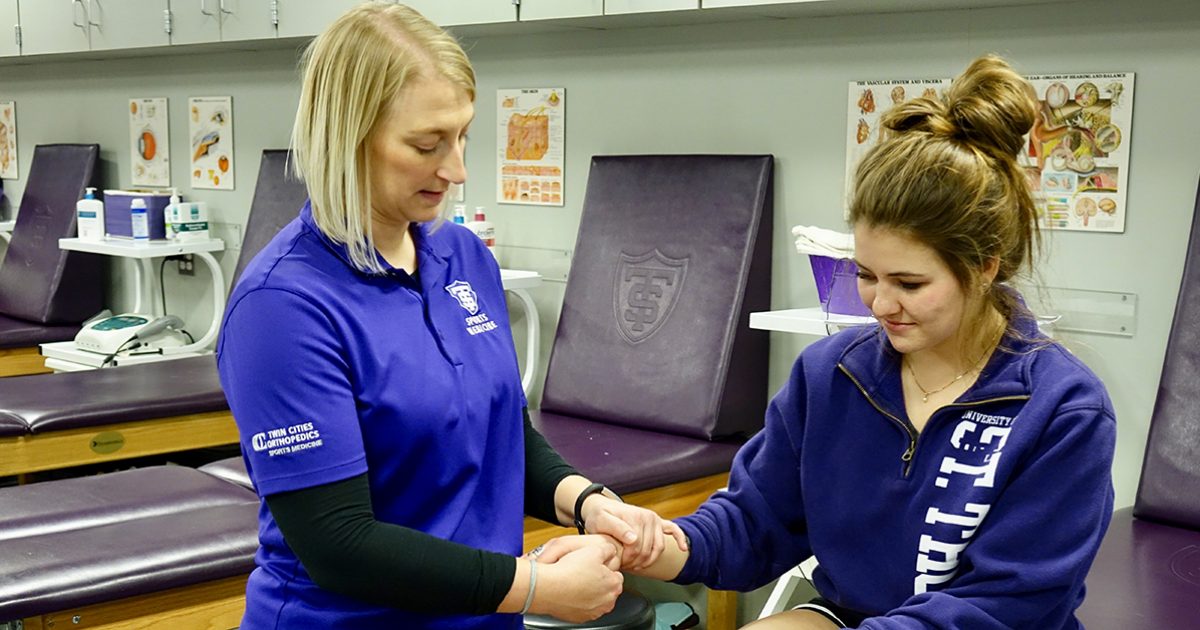
April 19, 2018 - TCO
TCO physical therapists enhance sports medicine coverage at 3 partner colleges
Twin Cities Orthopedics is a proud supporter of collegiate athletics and the Official Sports Medicine Provider for teams at seven colleges and universities in the Minneapolis-St. Paul metropolitan area and western Wisconsin. Typical sports medicine coverage for a school’s athletic program may include a team physician and certified athletic trainer. TCO takes it a step further at NCAA Division III schools Augsburg University, Hamline University and the University of St. Thomas by having board-certified sports physical therapists work directly with student-athletes in their schools’ athletic training rooms.
TCO PTs spend one to two half-days per week treating student-athletes during the fall and spring semesters.
“Being able to provide high-level sports physical therapy at our affiliate colleges really separates us in giving the best sports medicine outreach in the Twin Cities,” Mike Shirilla, DPT, SCS, PES, TCO’s sports medicine coordinator who oversees PT outreach, said. “It strengthens the sports medicine team by bringing in a sports rehab specialist.”
The high-quality care of a clinic, ‘in-house’
Auggies, Pipers and Tommies student-athletes are able to receive care from a TCO physical therapist on campus – often closer to their homes – rather than scheduling an appointment at a clinic.
“For the student-athletes, it’s easier for them to come into the athletic training room versus a clinic setting, where physical therapy traditionally is done,” said Maggie Dewitz, PT, DPT, SCS, a physical therapist at St. Thomas.
Student-athletes are busy with class, workouts, practices and games. By bringing a TCO physical therapist to them, care programs can be developed efficiently and take up less time while addressing their biggest needs.
Providing care in the athletic training room also allows PTs continuity and a chance to communicate directly with a multidisciplinary team, which includes the student-athlete, athletic trainer, physician, strength coach and head coach. Care teams develop treatment plans in person instead of by phone or email.
Athletic trainers are highly qualified in treating a number of orthopedic injuries. A physical therapist can bring a different skillset and perspective. Collaboration and communication between the two disciplines can help result in the best possible outcome for a student-athlete.
“The athletes I’m able to work with get the same quality care that they would receive in a TCO therapy setting,” said Brandon Schomberg, DPT, OCS, SCS, CSCS, TCO’s west metro therapy manager who works with Augsburg. “This ensures communication is not missed and that everyone is on the same page to get the athlete back to sport quickly and safely after an injury.”
Different perspectives provide well-rounded approach
Each health profession has some overlap. There are specialties or training an athletic trainer or physical therapist may not have that the other does that make collaboration better for the patient or student-athlete.
The biggest benefit is having two different backgrounds with similar goals working together, according to Dewitz.
“There are skillsets that PTs have and use more frequently that broaden our care profile,” Jim Rakow, ATC, who works alongside Dewitz as the Tommies head athletic trainer, said. “With those skillsets, if we function truly as a team and you each apply your top-end skillsets, your athletes get better. PTs round that out.”
Whether it’s student-athletes from teams currently playing or ones in their offseason, athletic training rooms can get full quickly. PTs are there to lend a helping hand when things get extra-busy.
“Having a physical therapist for the players provides an additional set of hands and eyes to help return them to their respective sport,” said Calvin Mai, DPT, SCS, CSCS, who works at Hamline. “Teams and student-athletes can get more individual attention as needed and help carry out recommendations per the athletic trainer and/or team physician.
“They provide unique challenges and opportunities that I may not experience every day in my clinical setting of orthopedics. You have to be adaptable to the in-season athlete and specific in rehabbing them to their respective sports.”
2-for-1; familiar territory
One TCO physical therapist spends time at two schools. Tonia Flategraff, PT, DPT, SCS, helps at Augsburg in the fall and Hamline in spring.
“Working at both schools has given me the opportunity to get to know the athletic training staff and the team physicians as we all work together to ensure the best plan of care for each athlete,” Flategraff said. “Plus, I get to help keep the Minnesota Intercollegiate Athletic Conference (MIAC) as competitive as possible by trying to keep the athletes at both schools healthy.”
One TCO physical therapist works in a familiar campus setting. Hamline alumnus and former baseball pitcher Brett Petersen, PT, DPT, MS, OCS, SCS, CSCS, helps get the Pipers back in the game.
“The opportunity to give back to my alma mater by working in the athletic training room is what drove me to start helping the athletic trainers,” Petersen said. “My role as physical therapist for Hamline has also allowed me to help the baseball team and be around the game that I love.”
Who doesn’t like a team?
The added bonus of working in a collegiate athletic training room is the chance to root for entire teams, not just a handful of student-athletes.
“Having a connection to a team makes you a lot more invested because you know more than one athlete,” Dewitz said. “Multiple people and multiple teams make it a lot more fun.”
Go to tcomn.com/community to learn more about TCO’s athletic partnerships throughout the community.

